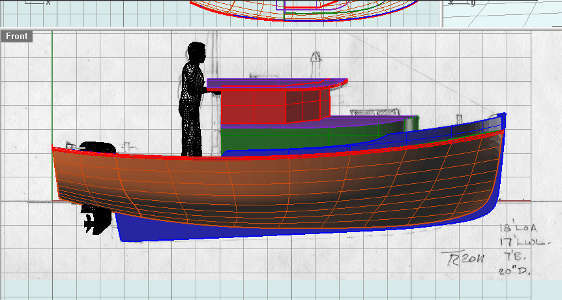Fidler 19, Gillnetter-style Displacement Cruiser
 Fidler 19, displacement cruiser based on BC gillnetters of the 1920-30s
Fidler 19, displacement cruiser based on BC gillnetters of the 1920-30s Fidler 19, displacement cruiser based on BC gillnetters of the 1920-30s. Shown with the Timbercoast Troller 22.
Fidler 19, displacement cruiser based on BC gillnetters of the 1920-30s. Shown with the Timbercoast Troller 22. Fidler 19, displacement cruiser based on BC gillnetters of the 1920-30s. Profile.
Fidler 19, displacement cruiser based on BC gillnetters of the 1920-30s. Profile. Fidler 19, displacement cruiser based on BC gillnetters of the 1920-30s. Construction detail.
Fidler 19, displacement cruiser based on BC gillnetters of the 1920-30s. Construction detail. Fidler 19, displacement cruiser based on BC gillnetters of the 1920-30s. Construction detail.
Fidler 19, displacement cruiser based on BC gillnetters of the 1920-30s. Construction detail.
Similar Designs
About the Plans
Construction Method and Materials:
3/4” Red Cedar strip planking over plywood bulkheads. Outside sheathed with Vectra, Xynole, or Dynel cloth in epoxy. Interior joinery all fillet and taped to hull. Plywood decks and house. Laminated Fir keel, stem, and sternpost.Number and Type of Drawings:
6 sheets. Lines and offsets, general construction, profile and arrangement, construction sections, 2 sheets full size bulkheads and stem patterns.Study Plan:
Fidler 19 Study Plan PDF
Design Comments

With styling and arrangement closely based on BC gillnetters of the 1920-30’s, the Fidler 19 is a minimum BC Coastal displacement cruiser. This is about the smallest boat able to take one or two folks north for an entire summer. She has the displacement and freeboard to handle very large loads without it affecting fuel consumption much. The hull is large volume with good deadrise and hard bilge turn amidships, her ends are fine for best efficiency at low speed. The engine is in a well and intended to be left down thus no transom cutout. If a builder wants the ability to lift the motor the cutout can be enlarged, but aesthetically I greatly prefer the intact transom.
With more cabin than cockpit she will keep the crew comfortable in the pouring rain or a stiff northwest on the nose. Accommodation is basic, a helm seat, galley counter, and large double berth. But she does boast the luxury of headroom to sit up in the berth. Of course a porta-pottie can be sited under the berth. Fuel is under the cockpit sole and there are large storage lockers either side of the engine well.
